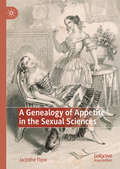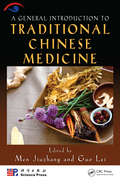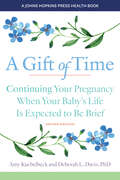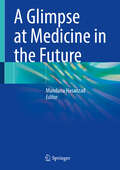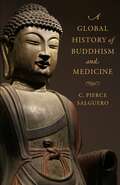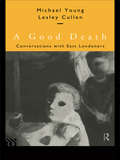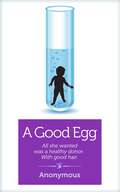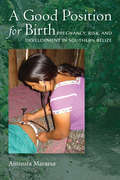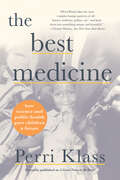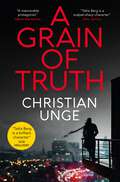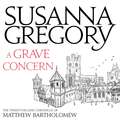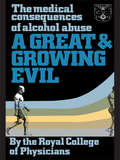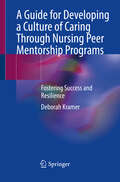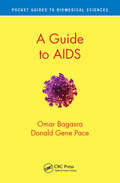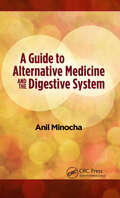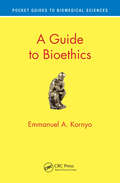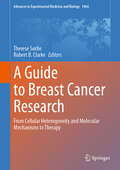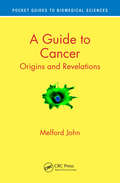- Table View
- List View
A Genealogy of Appetite in the Sexual Sciences
by Jacinthe FloreThis book offers a genealogy of the medicalisation of sexual appetite in Europe and the United States from the nineteenth to twenty-first century. Histories of sexuality have predominantly focused on the emergence of sexual identities and categories of desire. They have marginalised questions of excess and lack, the appearance of a libido that dwindles or intensifies, which became a pathological object in Europe by the nineteenth century. Through a genealogical approach that draws on the writings of Michel Foucault, A Genealogy of Appetite in the Sexual Sciences examines key ‘moments’ in the pathologisation of sexuality and demonstrates how medical techniques assumed critical roles in shaping modern understandings of the problem of appetite. It examines how techniques of the patient case history, elixirs and devices, measurement, diagnostic manuals and pharmaceuticals were central to the medicalisation of sexual appetite. Jacinthe Flore argues that these techniques are significant for understanding how a concern with ‘how much?’ has transformed medical knowledge of sexuality since the nineteenth century. The questions of ‘how much?’, ‘how often?’ and ‘how intense?’ thus require a genealogical investigation that pays attention to the emergence of medical techniques, the transformation of forms of knowledge and their effects on the problematisations of sexual appetite.
A General Introduction to Traditional Chinese Medicine
by Men Jiuzhang Guo LeiEstablished by the Western Han dynasty more than 2,000 years ago, Traditional Chinese Medicine (TCM) is currently finding increased acceptance. A General Introduction to Traditional Chinese Medicine explores the thinking behind TCM, its philosophy-based theory, and its cutting-edge uses in today‘s clinical practice. The book covers:Establishment an
A Gift of Hope: The Tony Melendez Story
by Mel White Tony MelendezFrom the Publisher: The inspiring story of a young thalidomide victim and talented musician who has gained international recognition. Wonderful reading for anyone--especially those facing seemingly insurmountable difficulties. ... This is a beautifully, and positively, written autobiography. Melendez neither downplays his and his family's struggles resulting from his lack of arms, nor does he whine about them. Writing about his father, "Still, he knew that only in America would he find the kind of medical treatment I needed, so he put his own dreams aside and began to dream for me. He was young, strong, and determined to provide for each of us-but especially, I believe, for me. Imagine his growing frustration as he tried to support us on the minimum wage jobs that he could find. And there was no extra time or money to train in another field. [In Nicaragua, he was educated and accomplished in the fields of agriculture and animal husbandry.] Instead, he found himself in a huge pool of cheap labor as more and more unskilled young people migrated to America."
A Gift of Time: Continuing Your Pregnancy When Your Baby's Life Is Expected To Be Brief (A\johns Hopkins Press Health Book Ser.)
by Amy Kuebelbeck And Deborah L. DavisA Gift of Time: Continuing Your Pregnancy When Your Baby's Life Is Expected to Be Brief
by Amy Kuebelbeck Deborah L. DavisA Gift of Time is a gentle and practical guide for parents who decide to continue their pregnancy knowing that their baby's life will be brief. When prenatal testing reveals that an unborn child is expected to die before or shortly after birth, some parents will choose to proceed with the pregnancy and to welcome their child into the world. With compassion and support, A Gift of Time walks them step-by-step through this challenging and emotional experience—from the infant's life-limiting prenatal diagnosis and the decision to have the baby to coping with the pregnancy and making plans for the baby’s birth and death. A Gift of Time also offers inspiration and reassurance through the memories of numerous parents who have loved a child who did not survive. Their moving experiences are stories of grief—and of hope. Their anguish over the prenatal diagnosis turns to joy and love during the birth of their child and to gratitude and peace when reflecting on their baby’s short life.Full of practical suggestions for parents and for caregivers, A Gift of Time also features the innovative concept of perinatal hospice and palliative care. Caring and thoughtful, the book helps parents embrace the extraordinary time they will have with their child.
A Glimpse at Medicine in the Future
by Mandana HasanzadThis book covers various aspects of the future of medicine, focusing on innovations in diagnostics, patient care, and drug discovery. With an increasing understanding of the structure and function of the human genome, along with continually improving laboratory and computational technologies, genomics has become progressively integrated into the core of biomedical research, medical practice, and the community. We are at the beginning of a fundamental shift in medicine, moving away from treating disease symptoms and toward curing diseases at their molecular causes. Artificial intelligence will aid in developing individually tailored therapies, gathering and exchanging big data, and advancing telemedicine to bring critical medical expertise to more patients worldwide. The future of medical artificial intelligence looks very promising, demonstrating that artificial intelligence can improve healthcare delivery. The twentieth century saw rapid advancements in disease prevention, including vaccine development and risk-factor prediction and intervention, nearly doubling global life expectancy. Healthcare has already entered the next phase of remarkable progress two decades into the twenty-first century. This book will be useful for health professionals interested in the future of medicine.
A Global History of Buddhism and Medicine
by C. Pierce SalgueroMedicine, health, and healing have been central to Buddhism since its origins. Long before the global popularity of mindfulness and meditation, Buddhism provided cultures around the world with conceptual tools to understand illness as well as a range of therapies and interventions for care of the sick. Today, Buddhist traditions, healers, and institutions continue to exert a tangible influence on medical care in societies both inside and outside Asia, including in the areas of mental health, biomedicine, and even in responses to the COVID-19 pandemic. However, the global history of the relationship between Buddhism and medicine remains largely untold.This book is a wide-ranging and accessible account of the interplay between Buddhism and medicine over the past two and a half millennia. C. Pierce Salguero traces the intertwining threads linking ideas, practices, and texts from many different times and places. He shows that Buddhism has played a crucial role in cross-cultural medical exchange globally and that Buddhist knowledge formed the nucleus for many types of traditional practices that still thrive today throughout Asia. Although Buddhist medicine has always been embedded in local contexts and differs markedly across cultures, Salguero identifies key patterns that have persisted throughout this long history. This book will be informative and invaluable for scholars, students, and practitioners of both Buddhism and complementary and alternative medicine.
A Good Death: Conversations with East Londoners
by Michael Young Lesley CullenA Good Death is based on a survey in East London and provides a wide range of fascinating and helpful insights into all aspects of experiencing death and surviving grief.The voices in the book are those of people who have managed to cope despite being under the shadow of impending death. Their experience could be a comfort to anybody in a similar situation. A Good Death is intended for people who are dying, for their lay and professional carers and for student doctors, nurses and social workers.
A Good Death?: Law and Ethics in Practice
by Simon WoodsThis interdisciplinary collection presents valuable discourse and reflection on the nature of a good death. Bringing together a leading judge and other legal scholars, philosophers, social scientists, practitioners and parents who present varying accounts of a good death, the chapters draw from personal experience as well as policy, practice and academic analysis. Covering themes such as patients’ rights to determine their own good death, considering their best interests when communication becomes difficult and the role and responsibilities of health professionals, the book outlines how ethical healthcare might be achieved when dealing with assisted suicide by organizations and how end of life services in general might be improved. It will be of interest to students and academics working the area of medical law and ethics as well as health professionals and policy-makers.
A Good Egg: All She Wanted Was a Healthy Donor. With Good Hair.
by Anonymous AnonymousShe&’ll do anything to become a mother—including stalking prospective egg donors&’ profiles on Facebook. In this hilarious yet poignant memoir of one woman&’s quest to conceive, the brave new world of artificial baby-making takes an unexpected turn when social media comes into play. As the not-quite-young-enough author obsessively examines the online antics of her nubile egg donor wannabes, she questions what it means to be a mother and, in the process, discovers the meaning of love.
A Good Position for Birth: Pregnancy, Risk, and Development in Southern Belize
by Aminata MaraesaIn order to understand the local realities of health and development initiatives undertaken to reduce maternal and infant mortality, the author accompanied rural health nurses as they traveled to villages accessible only by foot over waterlogged terrain to set up mobile prenatal and well-child clinics. Through sustained interactions with pregnant women, midwives, traditional birth attendants, and bush doctors, Maraesa encountered reproductive beliefs and practices ranging from obeah pregnancy to 'nointing that compete with global health care workers' directives about risk, prenatal care, and hospital versus home birth.Fear and shame are prominent affective tropes that Maraesa uses to understand women's attitudes toward reproduction that are at times contrary to development discourse but that make sense in the lived experiences of the women of southern Belize.
A Good Position for Birth: Pregnancy, Risk, and Development in Southern Belize
by Aminata MaraesaIn order to understand the local realities of health and development initiatives undertaken to reduce maternal and infant mortality, the author accompanied rural health nurses as they traveled to villages accessible only by foot over waterlogged terrain to set up mobile prenatal and well-child clinics. Through sustained interactions with pregnant women, midwives, traditional birth attendants, and bush doctors, Maraesa encountered reproductive beliefs and practices ranging from obeah pregnancy to 'nointing that compete with global health care workers' directives about risk, prenatal care, and hospital versus home birth. Fear and shame are prominent affective tropes that Maraesa uses to understand women's attitudes toward reproduction that are at times contrary to development discourse but that make sense in the lived experiences of the women of southern Belize.
A Good Time to Be Born: How Science And Public Health Gave Children A Future
by Perri KlassThe fight against child mortality that transformed parenting, doctoring, and the way we live. Only one hundred years ago, in even the world’s wealthiest nations, children died in great numbers—of diarrhea, diphtheria, and measles, of scarlet fever and tuberculosis. Throughout history, culture has been shaped by these deaths; diaries and letters recorded them, and writers such as Louisa May Alcott, W. E. B. Du Bois, and Eugene O’Neill wrote about and mourned them. Not even the powerful and the wealthy could escape: of Abraham and Mary Lincoln’s four children, only one survived to adulthood, and the first billionaire in history, John D. Rockefeller, lost his beloved grandson to scarlet fever. For children of the poor, immigrants, enslaved people and their descendants, the chances of dying were far worse. The steady beating back of infant and child mortality is one of our greatest human achievements. Interweaving her own experiences as a medical student and doctor, Perri Klass pays tribute to groundbreaking women doctors like Rebecca Lee Crumpler, Mary Putnam Jacobi, and Josephine Baker, and to the nurses, public health advocates, and scientists who brought new approaches and scientific ideas about sanitation and vaccination to families. These scientists, healers, reformers, and parents rewrote the human experience so that—for the first time in human memory—early death is now the exception rather than the rule, bringing about a fundamental transformation in society, culture, and family life.
A Grain of Truth
by Christian UngeStressed-out, sleep-deprived and pill-popping Dr Tekla Berg is as unusual a central character as you will find" Irish Independent"Tekla is a terrific character" Literary Review"Tekla Berg is a brilliant character" Susi Holliday"A memorable protagonist" Imran Mahmood"Tekla is a scalpel-sharp character" Jens LapidusA woman is found wandering the corridors of Nobel Hospital in Stockholm, accompanied by a young boy. She appears to be looking for a man who was involved in a car accident earlier that day.Meanwhile, in one of the emergency rooms, Tekla Berg is fighting to save a patient who was seriously injured in the same incident. The resulting chaos goes beyond anything anyone could have predicted, leaving hospital staff, police and everyone else involved equally shocked and perplexed.Hospital Director Monica Carlsson has stepped up her attempts to privatise her fiefdom with the launch of an exclusive patient hotel, a controversial liver transplant unit and the prestigious recruitment of star surgeon Klas Nyström. It soon becomes obvious that Klas has his own agenda and is working to undermine Tekla at every turn.But Tekla is too distracted to meet this challenge head on: she has become obsessed with the mystery surrounding the woman and her young charge - for the boy's identity remains unknown and no trace of his past can be found.Reviews for Hell and High Water"A gripping crime novel . . . fast-moving and packed with convincing detail and memorable characters" Literary Review"As gripping as it could be . . . An authentic and seriously exciting debut" Irish IndependentTranslated from the Swedish by George Goulding and Sarah de Senarclens
A Grain of Truth
by Christian UngeStressed-out, sleep-deprived and pill-popping Dr Tekla Berg is as unusual a central character as you will find" Irish Independent"Tekla is a terrific character" Literary Review"Tekla Berg is a brilliant character" Susi Holliday"A memorable protagonist" Imran Mahmood"Tekla is a scalpel-sharp character" Jens LapidusA woman is found wandering the corridors of Nobel Hospital in Stockholm, accompanied by a young boy. She appears to be looking for a man who was involved in a car accident earlier that day.Meanwhile, in one of the emergency rooms, Tekla Berg is fighting to save a patient who was seriously injured in the same incident. The resulting chaos goes beyond anything anyone could have predicted, leaving hospital staff, police and everyone else involved equally shocked and perplexed.Hospital Director Monica Carlsson has stepped up her attempts to privatise her fiefdom with the launch of an exclusive patient hotel, a controversial liver transplant unit and the prestigious recruitment of star surgeon Klas Nyström. It soon becomes obvious that Klas has his own agenda and is working to undermine Tekla at every turn.But Tekla is too distracted to meet this challenge head on: she has become obsessed with the mystery surrounding the woman and her young charge - for the boy's identity remains unknown and no trace of his past can be found.Reviews for Hell and High Water"A gripping crime novel . . . fast-moving and packed with convincing detail and memorable characters" Literary Review"As gripping as it could be . . . An authentic and seriously exciting debut" Irish IndependentTranslated from the Swedish by George Goulding and Sarah de Senarclens
A Grave Concern: The Twenty Second Chronicle of Matthew Bartholomew (Chronicles of Matthew Bartholomew #22)
by Susanna GregoryFor the twentieth anniversary of the start of the Matthew Bartholomew series, Sphere is delighted to reissue all of the medieval monk's cases with beautiful new series-style covers.------------------------------------The twenty second chronicle of Matthew Bartholomew. Identifying the murderer of the Chancellor of the University is not the only challenge facing physician Matthew Bartholomew. Many of his patients have been made worse by the ministrations of a 'surgeon' recently arrived from Nottingham, his sister is being rooked by the mason she has commissioned to build her husband's tomb, and his friend, Brother Michael, has been offered a Bishopric which will cause him to leave Cambridge.Brother Michael, keen to leave the University in good order, is determined that the new Chancellor will be a man of his choosing. The number of contenders putting themselves forward for election threatens to get out of control, then more deaths in mysterious circumstances make it appear that someone is taking extreme measures to manipulate the competition.With passions running high and a bold killer at large, both Bartholomew and Brother Michael fear the very future of the University is at stake.'A first-rate treat for mystery lovers' (Historical Novels Review)'Susanna Gregory has an extraordinary ability to conjure up a strong sense of time and place' (Choice)
A Grave Concern: The Twenty Second Chronicle of Matthew Bartholomew (Chronicles of Matthew Bartholomew #22)
by Susanna GregoryIdentifying the murderer of the Chancellor of the University is not the only challenge facing physician Matthew Bartholomew. Many of his patients have been made worse by the ministrations of a 'surgeon' recently arrived from Nottingham, his sister is being rooked by the mason she has commissioned to build her husband's tomb, and his friend, Brother Michael, has been offered a Bishopric which will cause him to leave Cambridge.Brother Michael, keen to leave the University in good order, is determined that the new Chancellor will be a man of his choosing. The number of contenders putting themselves forward for election threatens to get out of control, then more deaths in mysterious circumstances make it appear that someone is taking extreme measures to manipulate the competition.With passions running high and a bold killer at large, both Bartholomew and Brother Michael fear the very future of the University is at stake.
A Great and Growing Evil?: The Medical Effects of Alcohol
by Royal College of PhysiciansFirst published in 1987. Routledge is an imprint of Taylor & Francis, an informa company.
A Guide for Developing a Culture of Caring Through Nursing Peer Mentorship Programs: Fostering Success and Resilience
by Deborah KramerThis book describes in detail how to develop successful programs of nursing mentorship, utilizing concepts of caring that yields a strong, caring body of nurses who will be “nurse thrivers” as they find fulfilment and meaning in their professional commitment and will train others to do the same. The mentorship program is the ticket to success that many students need to complete their degree program, prevent burnout, pass the nursing NCLEX examination, and remain in the workforce after graduation. The current attrition rate in baccalaureate nursing programs is 25-50%, as is the attrition rate in the first 2 years of employment of new RN's entering the workforce. Burnout is due to a lack of care and support for helping the students navigate the rigor and demands of the nursing program. Creating a community of learners with caring and support creates an environment that fosters academic engagement and success. The unique aspect of this book is its focus on creating a caring environment to support the students; helping them develop caring skills, empathy, resilience and their own self-care; developing the skills for success beyond their educational process into the workforce. This book integrates all patterns of knowing - personal, aesthetic, empiric and ethical - and provides the missing link of peer mentorship necessary to the development of resilient, emancipated nursing students and graduates capable of working in community with others to establish cultures of care in health care. This is a must have resource for transformation of nursing education in the next century! Foreword by Dr. Margaret McClure.
A Guide to AIDS (Pocket Guides to Biomedical Sciences)
by Omar Bagasra Donald Gene PaceThe Guide to AIDS is succinct review of HIV/AIDS from a human-interest perspective. Chapters focus on some of the common patterns and prevention of HIV transmission and debunks misconceptions about HIV and AIDS. Brief descriptions the human immune system and epidemiology of HIV are included. The cultural component of disease, treatment and living with AIDS is central to much of this guide intended to synthesize, explain and de-mystify HIV and AIDS.
A Guide to Aging and Well-Being for Healthcare Professionals: Psychological Perspectives
by Norman M. BrierThis book provides practical evidence-based strategies that will help clinicians across a broad range of disciplines to address and discuss the main issues an aging person is likely to face and overcome if they are to maintain a sense of well-being as they age. Based on an extensive body of research, the relevant up-to-date knowledge for each topic is concisely presented, followed by practical, concrete, evidence-based suggestions as to how a healthcare provider might acknowledge and create a partnership with their clients to help the person increase their sense of well-being. Each chapter contains a list of key terms, a summary, and case examples that illustrate in realistic and humanistic ways how a person might present the concern being addressed and intervene. The specific challenges associated with aging that are addressed include: anxiety attached to an increasing awareness of mortality; retirement; the increasing number of losses of significant others; regrets; memory loss; the arrival of old-old age and feelings of loneliness, mattering insufficiently, and a loss of purpose; and finally, dealing with imminent death. This book is suitable for all health professionals who provide clinical services or advice to older adults including physicians (i.e. particularly in the specialties of internal medicine, family medicine, geriatrics, and geriatric psychiatry), nurses, social workers, psychologists, physical therapists, occupational therapists, and audiologists.
A Guide to Alternative Medicine and the Digestive System
by Anil MinochaA Guide to Alternative Medicine and the Digestive System is unique in that it provides answers to many practical clinical questions, all in one comprehensive resource. This single-authored handbook by Dr. Anil Minocha contains content supported by close to a 1,000 scientific citations. A Guide to Alternative Medicine and the Digestive System discusses the supportive evidence, and addresses safety issues, side-effects, and drug interactions.Dr. Anil Minocha is Board-certified in gastroenterology, internal medicine, nutrition as well as fellowship trained in clinical pharmacology and medical toxicology. This extensive background brings a systematic approach to evaluating, treating, and managing patients with alternative medicine options when treating conditions related to the digestive system.Readers will find more than 70 chapters of succinct information written in a user-friendly format inside A Guide to Alternative Medicine and the Digestive System.“Dr. Anil Minocha is well-known for writing useful, practical guides for quality care. His newest text, A Guide to Alternative Medicine and the Digestive System is no disappointment. This is an eloquent and elegant evidence-based approach to a challenging area.”-Jack A. Di Palma, MD, University of South Alabama, Former President of the American College of Gastroenterology“Dr. Minocha is to be applauded for his courage in tackling an issue, CAM, that the medical profession has traditionally chosen to ignore in the hope that it would simply go away. That CAM has stubbornly refused to disappear is a testament to its popularity with the general population and demands that we take it seriously, analyze why it is used and by whom and critically assess its efficacy and risks. For providing us with an accessible, fair and comprehensive critique of CAM in the context of modern medical practice, we all owe a debt of gratitude to Dr. Minocha."-Eamonn Quigley, MD, University College Cork, Ireland , Former President of the American College of Gastroenterology
A Guide to Bioethics (Pocket Guides to Biomedical Sciences)
by Emmanuel A. KornyoSolving intractable biotechnological questions of evolution, medicine, and genetics is now easier due to methods permitting the rapid analysis of molecular sequence data. These advances have exposed ethical and policy concerns. How would genomic information be used and by whom? Should individuals be able to make decisions regarding their own genomic data? How accurate are these genetic tests and how should they be regulated? These and other ethical conundrums are the subject of this book. Bioethicists, biomedical policy experts and lawyers, physicians, nursing and allied health students as well as science educators will find this book helpful and engaging in exploring the complexities of modern evolutionary, genetic and biomedical data.
A Guide to Breast Cancer Research: From Cellular Heterogeneity and Molecular Mechanisms to Therapy (Advances in Experimental Medicine and Biology #1464)
by Robert B. Clarke Therese SørlieThe book presents key topics at the forefront in breast development and cancer research in chapters authored by leading scientists in the field. The chapters provide a basis for understanding major concepts, model systems, cells of origin and heterogeneity in human breast development and cancer. The book builds on this understanding to guide readers through the cellular and molecular basis of breast cancer and the most important signaling pathways. Finally, the book describes mechanisms of metastasis and cancer immunity, and treatment options and resistance to therapy. It is targeted at young scientists and early career researchers and provides an overview of current topics in breast cancer research. Each chapter includes key learning points, boxes and conclusions to highlight the most important information. This book will interest anyone who wants to learn about the main areas of breast cancer research and the most important recent advances.
A Guide to Cancer: Origins and Revelations (Pocket Guides to Biomedical Sciences)
by Melford JohnA Guide to Cancer: Origins and Revelations unfolds the complex and fascinating topic of cancer in two ways: firstly, no specialist knowledge is assumed on the part of the reader, and secondly, despite the serious nature of the topics, the book aims to stimulate interest, provoke thought, and paradoxically entertain. It takes an array of complex topics and breaks them down in clear, concise terms, so that anyone with a basic knowledge of science can understand. The book is aimed at the general public as well as students of biological subjects, first and second year university students, and researchers in the nascent field of cancer genomics.
